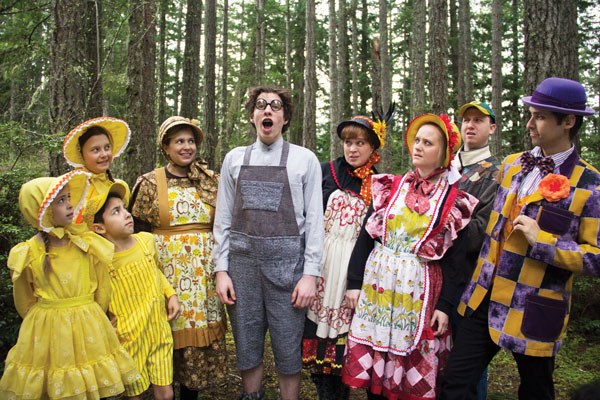
When I first learned The Mountaineers had a theater, I thought it was a bit strange. What does acting and drama have to do with mountaineering? The answer, in short, is community. Before forest access roads and rules that limit parties to 12, it was common for large groups of Mountaineers to spend days together just to get to where we now park our cars. To entertain each other in the evenings, animated camp-fire stories and performances, when organized with props, quickly became a type of theater.
The following is modified from The Mountaineers - A History:
In Search of a Lake
In the spring of 1909, a group of 66 Mountaineers were bushwhacking and hiking through narrow deer trails in search of Wild Cat Lake. A lake that is now, 100 years later, maintained by Kitsap County Parks and Recreation — complete with basketball courts, restrooms and a playground, easily accessible by road. They heard that a beautiful display of rhododendrons could be seen there in full bloom, and they thought it would make a good lunch destination.
They didn't find the lake that day (according to Google Maps, they were about a mile off as the crow flies), but they did find a rustic cabin in a lush green valley. More importantly, they found Edward Paschall's family and Hidden Valley Ranch. Edward and his two daughters, Mary and Patience, became an influential part of The Mountaineers. Edward worked with Mountaineers members like Peter McGregor to initiate the conservation of what has now become the 460-acre Rhododendron Preserve. Mary was one of the key women who helped build the new Kitsap Cabin in 1917, when most of the men were away due to World War I. And Patience attended multiple summer outings where unofficial plays were the highlight of the evening. These early staged performances led to the formation of The Mountaineers Players.
Early Pantomimes and Plays
The first official Mountaineers play was in June of 1923. It was a musical pantomime of Robin of Sherwood, complete with costumes, musicians, singers, dancers, and even a stage manager. Fueled by the performance's popularity and success, The Mountaineers continued putting on a play every year. In these early days, actors performed in the woods in a traveling troop, followed by the audience. Then, in 1926, volunteers built an official outdoor theater with dry, terraced seating to provide their enthusiastic audiences with more comfort (and no mosquitoes). This is where the theater stands today.
By the late 1920s, The Mountaineers Players had exploded in popularity. Now open to the public, as many as 1,450 people were known to squeeze into the small outdoor theater. Their rendition of Alice in Wonderland was so well received that the Seattle Chamber of Commerce requested a showing for convention-goers in Seattle.
These plays started with an annual spring performance to coincide with the blooming rhododendrons and quickly expanded to eight performances a year. Starting in 2007, there are now two shows each year — one in the spring and one in the summer. Some of the past shows have included Snow White and the Seven Dwarfs, A Midsummer Night's Dream, Annie Get Your Gun, and Cinderella. There have been performances every year, rain or shine except for a period between 1943 - 1946, during World War II.
A Magical Place still alive Today
Designated among Washington state's Natural Heritage Lands, the early preservation of this land created some of the most pristine natural habitat in Puget Sound. The forest floor often reaches a depth of six feet or more. Wild salmon populate the streams and and mature trees date back to the 17th century. The Mountaineers host Salmon Safaris in the spring to see schools of young salmon emerge from their gravel hiding places, and again in the fall when they return to spawn.
I had the opportunity to visit the Kitsap Forest Theater this April. Nestled among old growth trees, a winding path leads you to a unique outdoor amphitheater. Natural bark and live plants make up elements of the stage which is downhill from the surrounding seating area. It feels like a secret place children might create when left to their own in the woods, but much larger and better constructed. It does indeed seem to be inspired by magic.
Visiting the Kitsap Forest Theater
The Kitsap Forest Theater is open every spring and summer with two shows a year. This season's shows are The Music Man and The Little Mermaid. All shows are outdoors in terraced seating and start at 2pm. On show days, a round-trip shuttle bus is now available between the Bremerton Ferry dock and the Kitsap Forest Theater.
To learn more or buy tickets, visit www.foresttheater.com
 Suzanne Gerber
Suzanne Gerber
